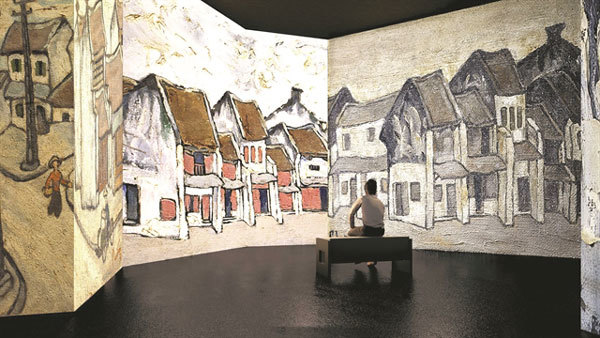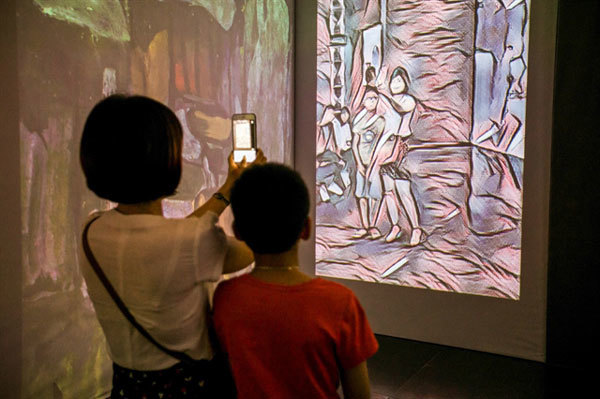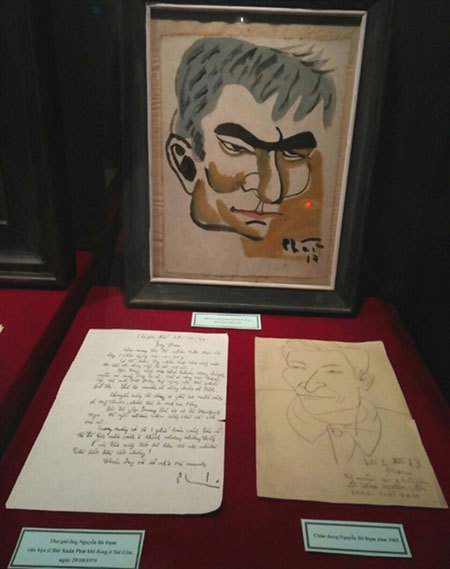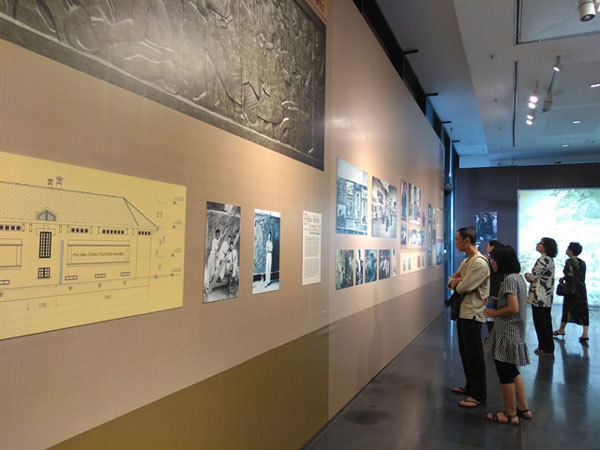 |
| Modern technology brings the feeling like we are sitting in Bui Xuan Phai's paintings of streets. Photo courtesy of exhibition's organiser |
Artificial intelligence technology identified you and imitated the style of Phai to create the painting, then projected your portrait on to the wall.
The amazing experience is a part of an exhibition showing Phai’s works using 3D mapping technology and multimedia art, including light and sound systems, to create an immersive space.
 |
| Thanks to AI technology, visitors can become characters in Phai's paintings. VNS Photo Minh Thu |
This is the first time artworks by a master of Vietnamese fine arts have been presented in this way.
The exhibition opened on Friday at the Hanoi Museum showing 100 paintings in three categories – Hanoi’s streets, cheo (traditional opera), and sketches of family and friends – which have been digitised and screened with 3D mapping technology.
Phai is considered one of the most important Vietnamese painters of the 20th century, who immortalised the corners of the capital’s Old Quarter. He significantly influenced the development of contemporary, modern art in Vietnam, according to Nguyen Tien Da, the museum’s director.
“The visual and auditory exhibition will provide art lovers with an interactive experience and help them have a better understanding of Phai’s work and enjoy discovery in art,” he said.
“The 3D mapping technology enlarged the paintings, so it brings the feeling like you are walking through the streets in Phai’s creations,” he added.
 |
| On display are hand-written letters and portraits of researcher Nguyen Ba Dam, a close friend of Phai. VNS Photo Minh Thu |
One display includes hand-written letters and portraits of researcher Nguyen Ba Dam, a close friend of Phai. Dam kindly donated these objects to the museum.
Through the letters, people can learn more about the relationship between Phai and other artists as well as his interest in books and art.
“Dear Dam, when you receive this letter, I am going to return to Hanoi,” Phai wrote in a letter to Dam in 1979.
“I will bring home nearly 20 books on fine arts, most of them are gifts from my friends here. I tried to buy the book you like, but I couldn’t find it.”
The exhibition will last until October 25.
 |
| Visitors learn about Indochinese fine arts and applied art of the first half of the 20th century in Vietnam. VNS Photo Minh Thu |
An exhibition featuring Indochinese fine arts and applied art of the first half of the 20th century also opened at the Hanoi Museum on the same day.
The exhibition, showcasing 200 paintings, sculptures, and architectural works in different media owned by the museum or private collectors and organisations, provides a brief introduction to the modern development of Vietnam’s fine arts and the establishment of the Indochina Fine Arts School, the foundation of the current Vietnam Fine Arts University.
The school was established on October 27, 1924, following the decision of Governor General of Indochina Martial Merlin. French artist Victor Tadieu and Vietnamese artist Nam Son laid the foundations for the school. This was an important turning point in national art history.
In November 1925, the first course opened with two main subjects: painting and sculpture. One year later, architecture was opened as another subject, followed by lacquer, silver carving, pottery and wooden furniture. Since 1931, works of artists trained from the school were displayed in many countries such as Japan, France, Italy and Belgium.
The exhibition recalls the golden period of Vietnamese fine arts, which happened during the transition from traditional art to modern Western art while retaining traditional elements. During 25 years of operation, many artists have been trained at the Indochina Fine Arts School and therefore are able to contribute to the country’s fine arts.
On display are images of the mural at Indochina University (former name of the Vietnam National University, located at 19 Le Thanh Tong Street, Hanoi).
Tadieu (1870-1937) created the 77sq.m-piece in 1921. The painting shows more than 200 characters in Vietnamese society. It took six years to complete the painting, marking Tadieu’s last of such a large scale.
The exhibition also presents the application of art in fashion, architecture and design. Hence visitors have a chance to contemplate architecture of houses in Hanoi in the 20th century, stamps and newspapers, ao dai (traditional long dress), decorative objects and public art.
“Fine arts with its own language spoken through lines, shapes, lights, layouts and colours, are expressed by Vietnamese artists, sculptors and architects through their ingenuity,” director Da said.
“Due to the limited time and space, the exhibition has not yet introduced the creative achievements of the fine arts from this period. We try to introduce the highlighted artworks.”
The exhibition will last until March 15, next year at the Hanoi Museum, 2 Pham Hung Street, Hanoi.
VNS
 Standing in front of the camera, you soon realise that you have become part of a painting by a prominent Vietnamese artist, Bui Xuan Phai (1920-1988).
Standing in front of the camera, you soon realise that you have become part of a painting by a prominent Vietnamese artist, Bui Xuan Phai (1920-1988).